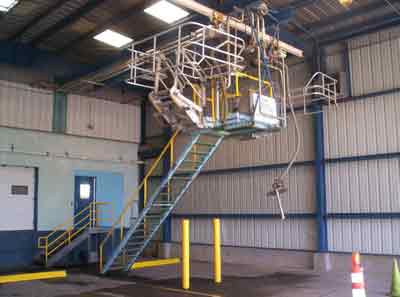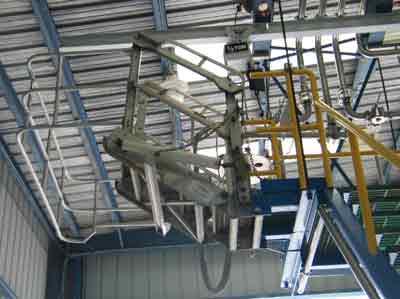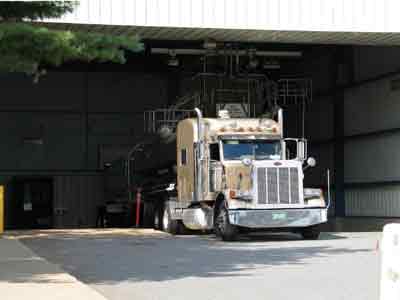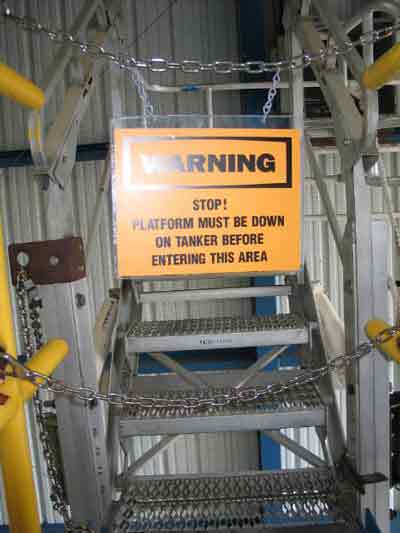A Painter Falls 12 Feet While Painting a Pump Hose Platform System - Massachusetts
Massachusetts Case Report: 07-MA-025
Release Date: January 5, 2009
Summary
On May 12, 2007, a 37-year-old male immigrant worker (victim) was fatally injured when he fell while painting a fixed raised pump hose platform system located in a loading dock area. He was an employee of a painting contractor hired to paint the platform system by the platform’s owner, an agricultural cooperative that specializes in manufacturing juice. The victim was on one of the platform system’s gangways when the gangway lowered causing him to lose his balance and fall approximately 12 feet to a concrete floor below. Emergency medical services (EMS) and the local police department were called by an employee of the agricultural cooperative. EMS and the local police department arrived within minutes. EMS transported the victim to a local hospital where he was pronounced dead. The Massachusetts FACE Program concluded that to prevent similar occurrences in the future, employers should:
- Ensure that fall protection and relevant training are provided to employees who are exposed to fall hazards when working six feet or more above a lower level.
Companies and outside contractors hired to paint equipment/machinery should:
- Conduct a joint job safety analysis (JSA) of the work area and tasks to be performed to ensure worker safety.
Franchise corporate headquarters should:
- Develop mandatory policies for health and safety practices to be included as requirements in franchise agreements.
Liquid product manufacturers utilizing pump hose platform systems should:
- Ensure that gangways when not in use are locked in the stored position with warning signs posted at the gangway entrance areas.
- Consider the feasibility of using bottom filling equipment and tanker trucks.
Introduction
On May 30, 2007, the Massachusetts FACE Program was notified by the Occupational Safety and Health Administration (OSHA) through the 24-hour Occupational Fatality Hotline that on May 12, 2007, a 37-year-old male worker employed by a painting contractor was fatally injured
when he fell from a platform system that he was painting. An investigation was initiated. On
July 10, 2007, the Massachusetts FACE Program Director traveled to the office of the painting
contractor and met with a painting contractor representative. On August 14, 2007, the Program
Director traveled to the incident location and met with a representative of the agricultural
cooperative that hired the painting contractor. The police report, death certificate, and publicly
available information for both companies were reviewed during the course of the investigation.
In addition, photographs of the incident location were taken.
The employer, a painting contractor, was a franchisee of a painting corporation. The painting corporation has approximately 300 franchises throughout North America and also international locations. The employer’s franchised location had been in business for approximately four years at the time of the incident and employed ten office workers and about 45 painters including the victim, who had been working for the contractor for 11 months. The employer representative reported that a few months prior to the incident, their painters were no longer their own employees but were now hired through an employment agency. The typical size of a crew sent to a painting project was approximately four painters. It was reported that the painters would routinely turnover. The victim was an immigrant from Angola who came to the United States in 2001. While living in Angola, the victim had worked as an English teacher.
Each franchisee was responsible for establishing health and safety policies and ensuring that these policies were implemented. The employer did have a staff person who devoted half of his work time to employee health and safety. The painting contractor also had a written health and safety program, an employee safety manual, and provided employees health and safety training that included classroom time, videos, and on-the-job training. All trainings were documented and the painting contractor reported that the trainings were provided in English, Spanish and occasionally in Portuguese. Employees were not part of a collective bargaining unit.
Investigation
An agricultural cooperative had hired the painting contractor to repaint sections of their fixed raised metal pump hose platform system (Figure 1) and some structural steel beams in the section of building where the platform system was located. This section of building is a hanger style building with a roof and walls enclosing three sides. The fourth side of the building is open to create access for trucks to back under the pump hose platform.
The colors of the platform system and steel beams were to remain the same: blue, white, and yellow. The blue painted areas included the stringers for the metal stair, sections of the platform’s base, and some sections of the steel I-beams. The white painted areas included sections of the platform’s base and some sections of the steel I-beams. The yellow painted areas included railings for the stairs and the platform. The job was estimated to take less than two days to complete.
The agricultural cooperative required that outside contractors hired to perform work within their facilities become qualified vendors. The painting contractor had done work for this liquid product manufacturer at this facility in the past and had become a qualified vendor in 2003. To become a qualified vendor a representative of the contractor was required to attend a six part contractor safety program, which included such topics as contractor safety checklists, and contractor personnel training certification statements. The contractor representative who participated in the contractor safety program would then relay the safety information to their company/employees. Qualified vendor status did not have to be renewed because it did not expire.
The agricultural cooperative had purchased the pump hose platform system involved in this incident new in 1992. The platform system, a double sided truck loading rack, was designed to load liquid product into the top of tanker trucks. This platform system had been altered once by the liquid product manufacturer. This alteration consisted of increasing the height of the platform system’s guardrails to make the system safer for employees. The platform system had regularly scheduled maintenance provided by the liquid product manufacturer.
The platform system has one set of stairs that leads from the ground level to a raised fixed platform area located approximately 10 feet above the floor. Gangways are located on the left and right sides of the raised fixed platform area (Figure 2). The gangways have three hinged steps and are used to access ports located on the top of a tanker trailer when the trailer is positioned properly next to the platform system. The ends of the gangways are equipped with guardrails that enclose the end of the gangways where there is no flooring. These guardrails provide fall protection to the platform system user when a truck is in the appropriate positioned and the gangways are in use. When needed, the hinged gangways are manually lowered to a truck’s tank enabling a worker to access the top of the truck’s tank from the platform system via the gangway (Figure 3). When not in use, the gangways should be placed in the up or stored position and locked. The platform system is also equipped with a loading arm and a pump system. The loading arm and pump system are used to deliver liquid product into the truck’s tank. The end of the loading arm is placed in the truck’s port and the pump system is turned on to fill the tank.
On the day of the incident, a Saturday, the painting crew that consisted of three painters, including the victim and a supervisor, arrived at the worksite at 9:00 a.m. for their first day on this project. The victim had not been scheduled to work this day, but had requested to work additional hours. The painting contractor had rented a scissor lift that was at the site at the time of the incident; it was reported that the lift had not been used on the day of the incident.
The crew began the job using tools, such as wire brushes and grinders, to remove chipped and flaking paint and rust prior to painting. At the time of the incident, approximately 11:30 a.m., the crew was painting using paint brushes and rollers. The victim was standing on the platform system painting a blue steel beam above the platform system. Although all three co-workers and an employee of the agricultural cooperative saw the victim falling, no one witnessed the events immediately prior to the fall, including the point when he started to fall.
Multiple witnesses did state that they heard a loud noise which caused them to look towards the platform system and then observed the victim falling. It appears that the victim had stepped from the fixed raised platform out onto the unlocked gangway that would have been to his left while standing at the top of the platform’s stairs to reach a section of the overhead steel beam he was painting. When he stepped onto the gangway, the weight of his body may have caused the gangway to lower causing the victim to lose his balance and fall approximately 12 feet to the concrete floor below, landing head first.
A call was placed for emergency medical services (EMS) by an employee of the agricultural cooperative. Another employee of the agricultural cooperative, who was also a nurse, assisted and stayed with the victim until EMS and the local police arrived at the incident location several minutes later.
During the investigation a representative of the agricultural cooperative mentioned that there was a stepladder lying on its side at the incident location when he arrived at the scene. It is unclear if the victim had been using the stepladder on the platform or if the stepladder was at ground level at the time of the incident. The painting contractor had not mentioned the stepladder during the visit to their office.
The agricultural cooperative representative stated that they were currently reviewing their qualified vendor process. In addition, the liquid product manufacturer had added signs attached to chains strung across the gangway entrance areas that state “Warning Stop! Platform Must Be Down on Tanker Before Entering This Area”.
Cause of Death
The medical examiner listed the cause of death as blunt head trauma with skull and brain injuries.
Recommendations/Discussion
Recommendation #1: Employers should ensure that fall protection and relevant training are provided to employees who are exposed to fall hazards when working six feet or more above the lower level.
Discussion: OSHA regulation 29 CFR 1926.501, Duty to have fall protection, requires that employees on walking/working surfaces six feet or more above a lower level must be protected from falling by a guardrail system, safety net, or personal fall arrest system1. In this incident, the victim was painting and working from a platform system that had gangways with guardrails to protect workers during truck loading operations. The end sections of the gangways did not have flooring. Therefore a fall hazard greater than six feet exists when accessing these gangways while in the stored position, regardless of whether a tanker truck is properly positioned, and when accessing the gangways when in the down position without a tanker truck in place.
At the time of this incident, the victim was working from one of the gangways in the stored position and was consequentially exposed to a fall hazard of more than six feet. Therefore, the victim should have been supplied with fall protection, such as a personal fall arrest system, and been provided training on the fall protection. Another option would have been to use the rented aerial lift that was onsite at the time of the incident. Management procedures should be in place to ensure that employees are following required safety practices. In either scenario, because of the nature of the work and the availability of an aerial lift for use by the painting contractor employees, training should have been provided by the painting contractor to their employees about personal fall arrest systems and aerial lifts.
Recommendation #2: Companies and outside contractors hired to paint equipment/machinery should conduct a joint job safety analysis (JSA) of the work area and tasks to be performed to ensure worker safety.
Discussion: A job safety analysis (JSA) is a systematic way to evaluate how to perform tasks safely. It involves identifying all potential hazards and hazardous situations that could occur when performing tasks2. JSAs should be routinely performed to identify uncontrolled hazards by breaking down the tasks to be performed into steps. Each step should be evaluated to identify the hazards or potential hazards. Once hazards are identified, employers should take actions to eliminate or control these hazards.
Contractors and the companies that hire them should perform joint JSAs. A joint JSA should be performed at the worksite location after the project’s scope of work is defined and prior to the beginning of the project. The joint JSA should focus on the specific tasks to be completed and should take into consideration potential hazards within the facility to which the contractors could be exposed.
In this case, the agricultural cooperative would have the most knowledge of the platform system and any hazards that might be associated with the platform system and elsewhere in the facility. The painting contractor would know which tools and equipment they would use to complete the painting task. Sharing this information between the cooperative and the outside contractor while at the project location would help identify possible hazards that might not have been anticipated if the information was not shared or if the information was shared but not while at the project location.
Recommendation #3: Franchise corporate headquarters should develop mandatory policies for health and safety practices to be included as requirements in franchise agreements.
Discussion: Corporate headquarters with multiple franchised locations have an important role to play in health and safety practices of their franchisees. Headquarters should develop mandatory policies for corporate-wide health and safety practices, in the same way they require uniform branding, and the use of specific products throughout the entire franchised corporation.
At a minimum, franchise corporate headquarters should develop and provide franchisees with a model industry specific health and safety program plan that includes recommended health and safety practices as part of their franchise agreements. These health and safety programs could then be adapted by the individual franchisees for their specific locations. This will help promote consistency across the franchise and the individual franchisees in their health and safety programs and practices. As a reference, a summary of the Occupational Safety and Health Administration’s (OSHA) draft proposed safety and health program rule, which discusses the safety and health responsibility of employers, has been included at the end of this report.
In this case, corporate headquarters reportedly did not address health and safety policies and practices with the individual franchisee locations. Although the victim’s employer, a single franchise location, had made efforts to address occupational health and safety, support and resources from corporate headquarters might have improved the employer’s health and safety program and health and safety practices.
Recommendation #4: Liquid product manufacturers utilizing pump hose platform systems should ensure that when not in use gangways are locked in the stored position with warning signs posted at the gangway entrance areas.
Discussion: The pump hose platform system involved in this incident has raised platforms leading to gangways. When in use, these gangways are lowered to the top of tanker trucks. Since the incident, the agricultural cooperative has implemented procedures to be followed when the pump hose platform system is not in use. These procedures include, ensuring that the gangways are locked in the stored position and placing warning signs at the gangway entrance areas that state “Warning Stop! Platform Must Be Down on Tanker Before Entering This Area” (Figure 4).
Recommendation #5: Liquid product manufacturers utilizing pump hose platform systems should consider the feasibility of using bottom filling equipment.
Discussion:The pump hose platform system involved in the incident was designed to load a liquid product into the top of tanker trucks. Having the tanker trucks being filled from the top of the truck’s tank requires liquid product manufacturer’s employees and potentially outside contractor employees to perform tasks from an elevated platform and possibly exposing them to a fall hazard. Bottom loading tanker trucks will minimize the need for workers to work from heights during truck loading and maintenance tasks. Bottom loading can also potentially increase the speed of the loading task3,4.
References
- Code of Federal Regulations. 29 CFR 1926.501. Duty to have fall protection. Washington DC: U.S. Government Printing Office, Office of the Federal Register.
- DOL. OSHA. Job Hazard Analysis.pdf iconexternal icon Publication Number: 3071. [www.osha.gov/Publications/osha3071.pdf]. Date accessed: February 13, 2008.
- Bulk Transporter. Chevron Phillips Produces Precedent With Automatic Bottom-loading Rack.external icon January 1, 2002. [http://bulktransporter.com/archive/chevron-phillips-produces-precedent-automatic-bottom-loading-rack] Date accessed: February 13, 2008. (Link updated 8/13/2013)
- Massachusetts Department of Public Health. Occupational Health Surveillance Program. Massachusetts FACE project. Massachusetts Plant Operator Dies in Fall at a Petroleum Marketing Terminal (94MA007). [www.cdc.gov/niosh/face/stateface/ma/94ma007.html]. Date accessed: July 16, 2007.

|

|
 |
|
Figure 3 – Tanker truck positioned next to the platform system with a gangway lowered onto the truck’s tank. |
 |
|
Figure 4 – Gangway entrance area with warning sign. |
To contact Massachusetts State FACE program personnel regarding State-based FACE reports, please use information listed on the Contact Sheet on the NIOSH FACE web site Please contact In-house FACE program personnel regarding In-house FACE reports and to gain assistance when State-FACE program personnel cannot be reached.
